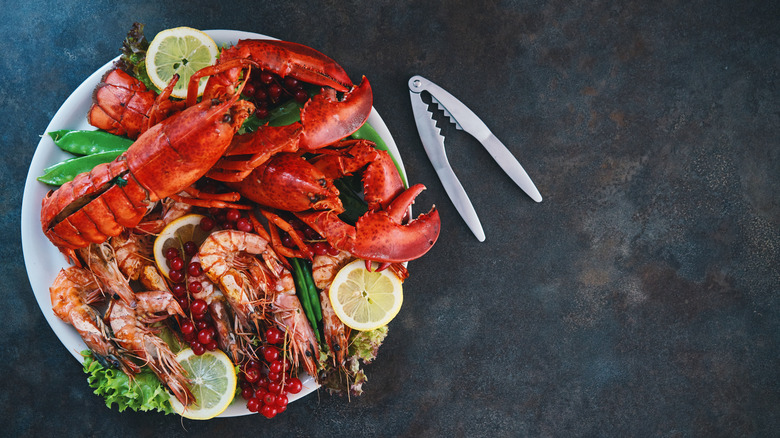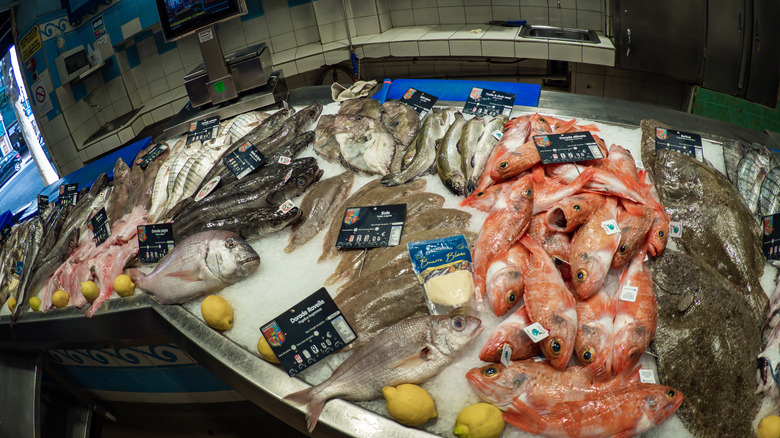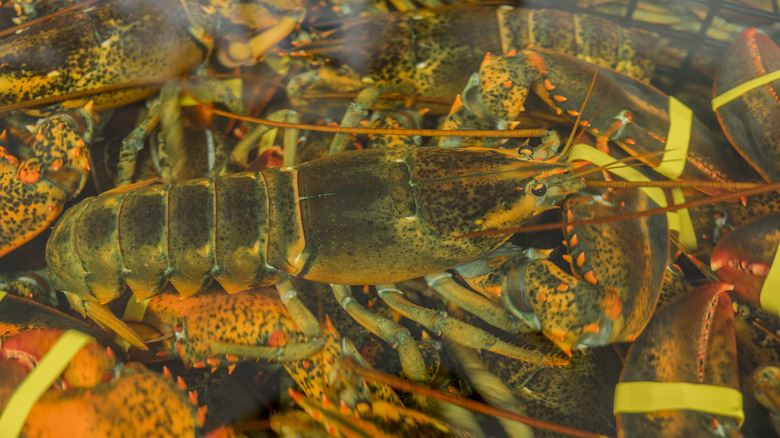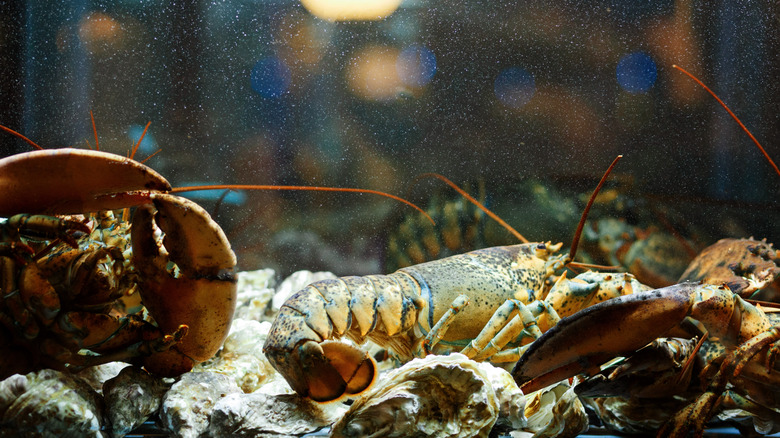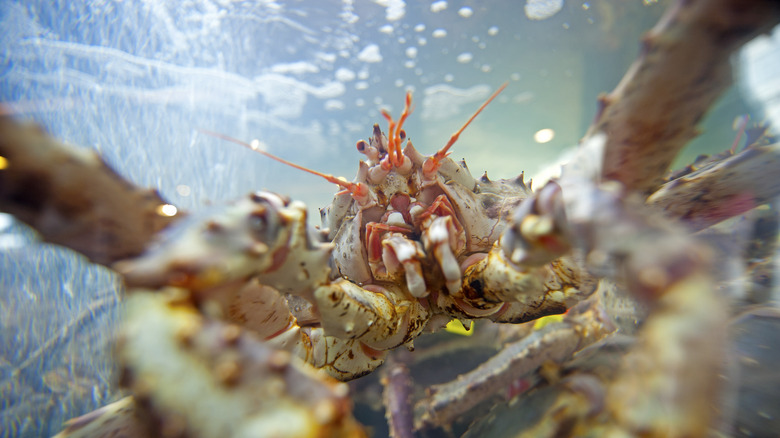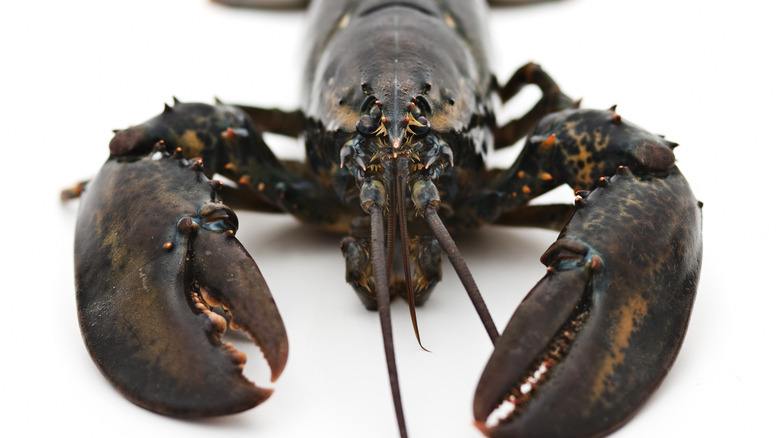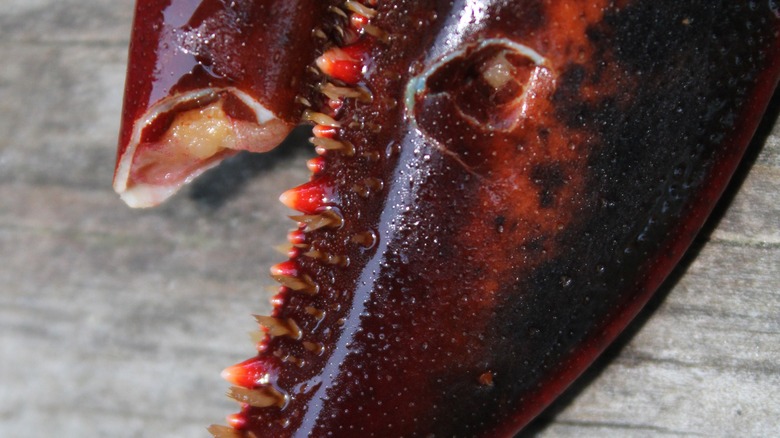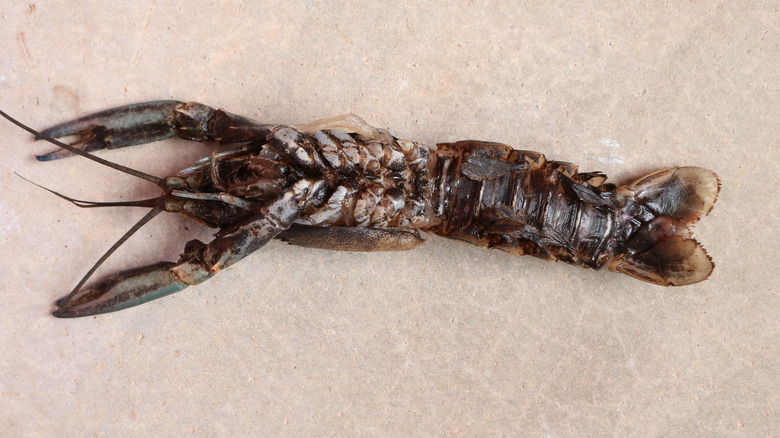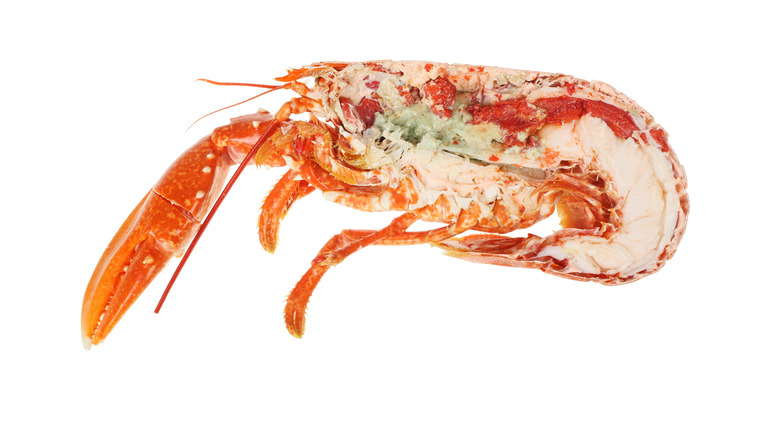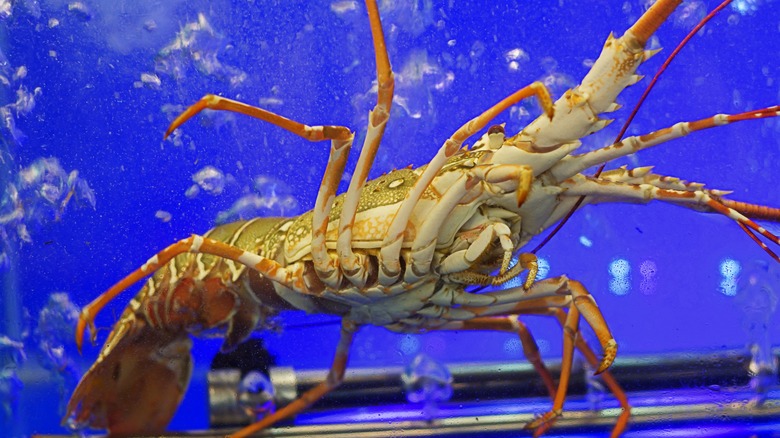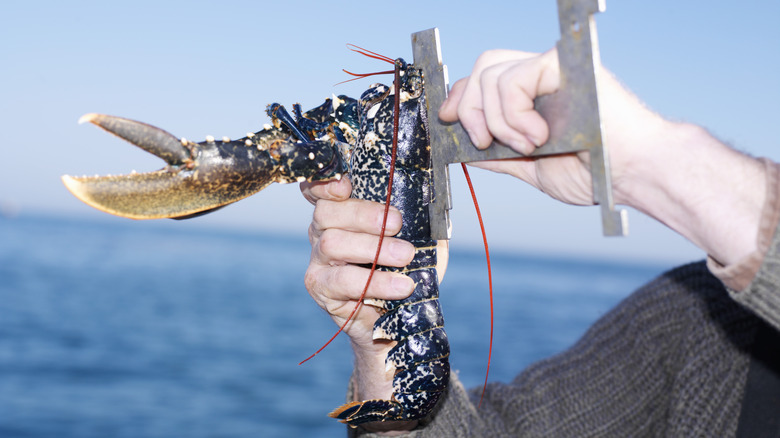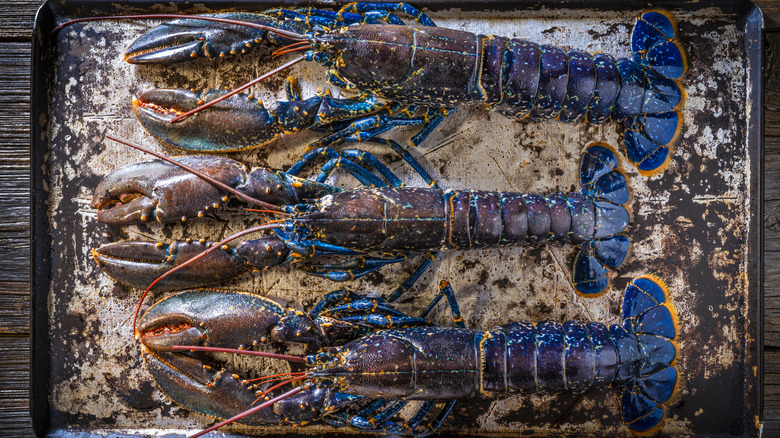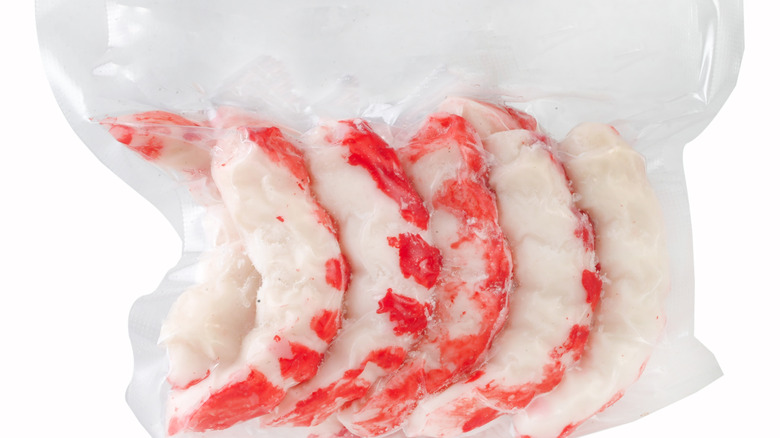Mistakes Everyone Makes When Buying Lobster
Lobster is expensive at restaurants, and when you consider how easy it is to prepare at home, the price hardly seems worth it. Lobster doesn't need loads of bells and whistles to make it delicious, at least not according to Jeff McInnis, Chef/Partner at Root & Bone Miami, Mi'talia Kitchen & Bar, and Stiltsville Fish Bar, who says that overcomplicating things is one of the most common mistakes when cooking lobster.
"Keep it simple!" he says. "Butter, sea salt, and lemon are all you need to dress a lobster. Don't overdo it."
Indeed, there are only a few ways a home cook might err when cooking lobster at home. The first, according to Isamar Leal, Chef Creative Director for Pasión Miami and Florida Education Institute, is not proceeding promptly enough. To this advice, Chef Jonathon Sawyer of Kindling adds a few tips regarding the humane slaughter of the crustacean, which should always be bought live. Home cooks, he says, "never kill them quickly & humanely. A quick stab through the back of the skull is globally recognized as the best option."
While cooking this shellfish is surprisingly simple, the most difficult thing to get right when it comes to lobsters is sourcing them. Although many supermarkets have a lobster tank, choosing the right one can be tough for the uninitiated. Luckily, we talked to several culinary professionals, and they shared their lobster best practices. Our experts are here to highlight the most common mistakes everyone makes when buying lobsters.
Choosing the wrong purveyor
Choosing where you source your food is of the utmost importance, according to Jonathan Sawyer — and it's even more important with delicate items like seafood, particularly pricy items like lobster.
"I cannot stress it enough, get to the people who sell you food. Especially the more expensive items," he says.
While, of course, he notes that many don't have easy access to top-notch fishmongers, he encourages home cooks to think outside of the box. "We do all typically use a grocery store that has the same or similar people working the specialized departments," he says. "So introduce yourself, say thank you, let them know they are a part of your table. Then, when the time comes to buy truffles or lobsters or maybe a special cut of pork, they'll remember you and reciprocate appreciation."
If you don't have a lobster purveyor near you, he adds, you can always source your lobsters online. If you do, he says, be sure that they're shipped in the most humane way to ensure you get the best quality product. Lobsters, he says, should be shipped individually to keep them from fighting in a dark, wet box.
"When done correctly, it looks like an old school postal box, with each lobster in its own mail slot, covered in seaweed from harvest location," he says.
Picking a dead lobster
When choosing your lobster from a tank, keep an eye out for ones that are listless or too still: They might be dead or dying. According to Leal, it's actually "fairly easy" to make a mistake and choose a dead one. "To avoid this, choose lobsters that are lively, moving, and react when touched."
McInnis agrees, noting he always keeps an eye out for "a fresh and lively one."
While it might seem odd to keep an eye out for a still-living lobster, this ensures it is as fresh as possible, translating to much better flavor. "Just like most animals, once the lobster dies, the body releases acids which will break down the meat quickly, making it soft and not appetizing," explains McInnis. Arguilla echoes this warning, noting that the meat of dead or dying lobsters degrades quite quickly. "Just like any shellfish," he says, "the fresher the better."
But flavor isn't the only reason choosing live lobster is best, according to Sawyer: There's also an ethical element at play. "Humanely harvesting, transporting, storing, and killing is an important tenet of how we cook food," says Sawyer. "We don't want to give more business to purveyors who don't take care of the animals we are going to eat."
Not checking for droopy claws and a curling tail
Even if a lobster is still moving, if it looks listless, it's likely close to dying — and that means it should be avoided at all costs. Luckily, there are a few things to keep an eye out for if you're not sure whether a lobster is lively enough: drooping claws and a tail that's too relaxed.
"A healthy lobster will actively move its claws and tail," explains Chef Francis Arguilla of Sushi | Bar Miami Beach. "Vigilance and careful observation are key to guaranteeing a fresh catch."
McInnis says that it's essential to look for a lobster with firmly clenched claws — a sure sign the lobster is "doing well and alive."
"If the claws are relaxed," he continues, "that's not a good sign."
As for the tail, it should be tightly curled, showing it's nice and strong. According to McInnis, a tail that's "relaxed or loose" indicates that the lobster is far from at the peak of health. Don't be shy about asking your fishmonger to take a closer look at your lobsters before you make a purchase. You don't want to spend money on a lobster that's on its way out.
Picking a lobster that's too aggressive
Listless lobsters are no bueno. On the contrary, a lively lobster indicates that it's robust, strong, and healthy, according to Arguilla. "One of the most common mistakes home chefs make when choosing a lobster is neglecting to consider the lobster's liveliness," he says. "Ensuring a live and healthy lobster is important for optimal flavor and texture for the end result."
McInnis echoes this, noting that when he's choosing his own lobsters, he gravitates towards "the social ones."
That said, while a social lobster is certainly a good sign, you don't necessarily want to pick the alpha of the tank, according to Leal. "Choose one that's not fighting," he suggests, noting that a lobster lingering at the bottom of the tank is "often less stressed and more likely to be healthy."
Arguilla agrees. "Lobsters showing calm behavior at the bottom of the tank are generally preferable to those engaged in erratic interactions," he says. "This calmness suggests lower stress levels, which can positively impact the lobster's texture and flavor."
Picking a lobster missing its antennae
Our chefs are divided in their opinion regarding a lobster's antennae or lack thereof. Arguilla notes that "while intact antennae are an indicator of freshness, their absence does not necessarily compromise the overall quality of the lobster." Indeed, he concludes, while far from ideal, "missing antennae on a lobster is not a significant concern."
Indeed, the antennae of lobster are not consumed, so a lobster devoid of them won't be any less delicious. That said, while missing antennae poses no health risks or gustatory woes, it does imply that the lobster may have been hanging around the tank too long and even engaging in aggressive behavior, which, as we've seen, could mean a lobster that's more stressed and thus less delicious. And it's not great from a humane perspective either, adds Sawyer. "Any missing body parts indicate it's a vendor who doesn't really care about the animal," he says.
Choosing a cracked lobster
Choosing a lobster with a cracked shell may seem to have many of the same connotations as choosing one with missing antennae, but the former is a bit more dire when it comes to the flavor of the finished dish, according to our experts.
"Missing antennae is not a big deal," says Leal. "Cracked shells can impact quality, so it's best to avoid them."
Indeed, a cracked or damaged lobster shell can impact the flavor and texture of the lobster, according to Demetrio Zavala, Director of Culinary for Gary Rack Restaurant Management Group. "It allows water to get in and the meat to be full of water," he says.
And once cooked, the cracked shell can have the opposite effect, according to Arguilla. "A cracked or damaged shell is a notable concern as it can lead to a loss of moisture during cooking, resulting in less succulent meat," he says. "It is advisable to select lobsters with intact, unblemished shells to preserve the quality of the final dish."
Mixing up soft- and hard-shell lobsters
Lobsters usually have a hard shell protecting them from predators, but during molting season (which, according to Sawyer, happens about twice a year), the shell softens — and our chefs are divided over whether that's the best or the worst time to enjoy them. On the one hand, explains McInnis, soft-shell lobsters can be easier to handle. "The new one is a tad easier to de-shell and break down," he says. And there's also a difference in flavor. "When a lobster is growing into a new shell, there is more space between the shell and the meat," he says. "This gives the lobster meat some room to marinate in the seawater, which gives a delicious brined and sweet flavor."
Arguilla echoes McInnis' enthusiasm for soft-shell lobsters. "While both are delectable, many chefs, including myself, appreciate the sweet and tender meat of soft-shell lobsters for certain culinary applications," he says. "The lobster basically cooks in its own juices when it's in the soft state."
But Sawyer notes that a soft-shell lobster is too fragile and difficult to transport to be worth the improved flavor. And at the end of the day, according to Leal, it really comes down to the individual.
"Soft-shell lobsters are considered sweeter, while hard-shell lobsters have a firmer texture," he says. At the end of the day, like so many choices, this one comes down to personal preference.
Picking a male when you want a female
The decision to pick a male versus a female lobster is also down to personal preference, according to our experts. "Males may have larger claws, while some prefer the roe of female lobsters," says Leal. (You know, that greenish goo you'll find in some specimens, which is positively packed with flavor and makes an excellent sauce for pasta or the lobster itself.)
For sustainability reasons, Sawyer prefers males, "especially if the females are carrying eggs on the underside of their tail. The continuation of wild lobster species is paramount, frankly, the females are way more important to that than the males."
Arguilla, meanwhile, prefers females for their better flavor. "The distinction between the two is primarily visual," he says, "with females having wider tails, but for my personal experience, the meat is much sweeter than the male counterpart."
Whichever you prefer, you can easily tell the difference, according to McInnis, by looking at the base of the tail, where it meets the body. On a male, he says, it will be thinner and straighter, with clean, smooth, firm legs. "The female has a tad more feathery-looking soft little legs under the tail area," he explains. "When breaking down the lobsters and cooking them, you'll see lobster roe located in the tail meat, and you will know it's a female."
Buying lobster out of season
If you live in the northern hemisphere, lobsters are at their best from July to December, according to Sawyer; Zavala says that the best season for lobster is even more restricted, from September to November. But while Sawyer notes that lobsters can be — and are — harvested year-round, just because you can get lobster out of season doesn't mean you should.
"In season, lobster is best as the meat is fresher," says McInnis, and Leal adds that in-season lobsters are generally more flavorful. "Out-of-season lobsters might be less sweet or robust," he says.
For Zavala, there's a good reason for this.
"In the summer, the lobsters come closer to the shore in warmer waters to shed their shell, causing them to have soft shells at this time," he says. So, if you want a sweet, succulent, soft-shell lobster, break out your favorite lobster recipes in the early autumn.
Picking the wrong size lobster
Lobsters are available in many different sizes, and according to McInnis, "In this case, bigger is better." Smaller lobsters weighing just a pound, he says, are more shell than meat. So, if you want the best bang for your buck, he recommends getting "the biggest one you can afford!"
That said, other experts note that the search for quantity should not outweigh quality — and often, smaller lobsters have better meat with a far more tender texture.
Arguilla agrees. "While larger lobsters are visually impressive and yield more substantial portions, smaller lobsters are prized for their tenderness and are often favored for certain dishes," he says, noting he prefers five-pound lobsters "for ultimate satisfaction."
Sawyer, meanwhile, prefers a slightly smaller lobster — somewhere between two and four pounds — which yields a good amount of flavorsome meat. This is as much for their flavor as for the propagation of the species; he says: "Older lobsters have had a better chance at procreation, which means we'll have way more lobsters to enjoy in the future." He steers clear of the younger cull lobsters, weighing 1 ½ pounds or less.
But Zavala, on the contrary, finds these smaller lobsters — between 1 ¼ and 1 ½ pounds — to be the peak of perfection, given their sweet, tender meat.
Mixing up the origins of your lobster
While in North America, most lobsters you'll find belong to the Homarus americanus species, there are many other kinds of lobsters, including European Homarus gammarus, with its slightly bluish shell or spiny Palinuridae, also known as rock lobsters, which are slightly more similar to langoustines. Each has its own merits, Leal explains, with Maine lobsters offering more sweetness and European lobsters boasting a delicacy you won't find elsewhere.
"Preferences between French, Canadian, and American lobsters are subjective and can vary," adds Arguilla. "Each region offers unique qualities, and the choice often depends on the desired flavor profile and culinary application."
As with other characteristics, then, this one comes down to personal preference. Zavala has a weakness for French lobsters, which, he notes, boast "a stronger sea taste" and more flavor than their American cousins. That said, most of our chefs prefer Maine lobsters, which Arguilla loves "for the soft texture and sweet flavor." Sawyer, too, prefers lobsters from Maine, which, he says, "really takes care of its fisheries, where and when and how much to harvest." He also notes that since lobsters thrive in cold water, it's best to "go north when given the opportunity." "The traditional Maine lobster" is also McInnis' go-to, though he does note that, at the end of the day, "I like 'em all."
Neglecting frozen lobster
Make no mistake: Frozen lobster pales in comparison to fresh. That said, sometimes, it's worth it, for example, if you live in an area where it's tough to access fresh, if lobster is out of season, or simply if you're looking for consistency, according to McInnis.
"Fresh is generally preferred, but frozen can be a practical choice, especially when fresh isn't readily available," echoes Leal. "Ensure it's high-quality frozen seafood."
"While fresh lobster is typically preferred for its superior texture, frozen lobster can be a convenient and high-quality alternative, especially when fresh lobster is not readily available," adds Arguilla, and indeed, for those who don't have access to fresh, frozen can be a safe and tasty alternative. "The freezing process can effectively preserve the lobster's taste and texture, but just with any shellfish, fresh is always preferred."
Frozen is particularly good for dishes that have a bit more bells and whistles than a classic steamed lobster. Lobster thermidor, which is topped with a crunchy herb and cheese combo, or lobster mac and cheese will be nearly as delicious with frozen lobster as with fresh — and they'll be far less expensive, too.
